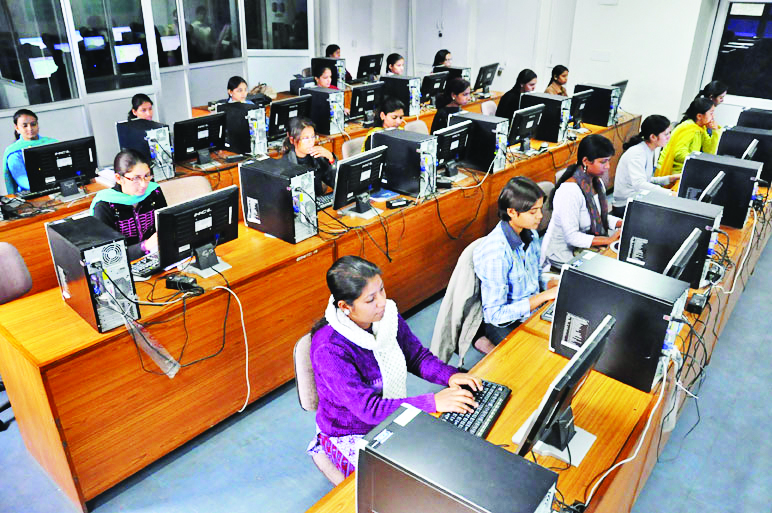
 Dr Shabistan Gaffar, Chairperson, Committee on Girls Education, National Commission for Minority Educational Institutions, shares her views about the importance of technical education in aiding women in India
Dr Shabistan Gaffar, Chairperson, Committee on Girls Education, National Commission for Minority Educational Institutions, shares her views about the importance of technical education in aiding women in India
women education in India has been given a lot of importance in all Five Year Plans with special emphasis on technical and vocational education with a view to enable the women to be economically independent and become better homemakers. It also aims at making a tremendous impact on the quality of life of women folk. Therefore, polytechnic education for women is very important part of education.
The report of Women Education 1937 expressed the view that women can definitely contribute in growth and development of the country. Therefore, it is essential to take suitable measures for expansion of vocational and technical education for women. Though the British government didn’t implement the recommendations of the report, it was only after independence that Indian government took steps to uplift the status of women by establishing National Women Council, which gave its report in the financial year 1956-1957. According to the report, only four percent girls were receiving education. This report laid emphasis on enhancing the facilities of vocational and technical education for women. During Second Five Year Plan, women technical education got a modest consideration with the establishment of a women polytechnic. On the recommendation of National Council for Women Education, it was started as a part of a women’s welfare programme. Women’s education expanded fairly in post-independence period, but Muslim women education was better than average literacy of India in pre-independence period. So during 1951-1981, percentage of literacy among women increased from four percent to 7.93 percent and upto 24.82 percent according to Programme of Action 1986 (National Policy of Education). By 1991, it increased upto 39.42 percent (Aajkal 1991). Due to socio-cultural and socioeconomic reasons, institutions for girls’ education and technical education were established relatively late as compared to those for boys. The first co-educational polytechnic was established in 1937.
It was a round 1961 that two polytechnics for women were started in Delhi and Bangalore after recommendation of National Council for Women. The main purpose of such institutions was a social welfare activity, but definitely as a development activity as well.
National Policy of Education 1986 was a major landmark in the evolution of status of women in India. The policy addressed the issue of equality of educational opportunity for women |
Social change is a function of economic development and cultural transformation, which automatically follows development of nation. One may further say that social change and cultural transformation is by-product of economic development. The policymakers also realised that women must have equal contribution in economic growth and development of country. This has also been recognised by the constitution. It has also been experienced that higher education courses like BA, MA, etc. are of little relevance in professional world and don’t enhance employment opportunities for the women. Hence, there is a need to promote technical and vocational skills in the women for economic independence. National Policy of Education 1986 was a major landmark in the evolution of status of women in India. The policy addressed the issue of equality of educational opportunity for women. The policy of non-discrimination is pursued vigorously to eliminate sex-stereotyping in vocational and professional courses and to promote women’s participation in non-traditional occupations as well as in existing and emerging technologies.
National Policy for Empowerment of Women formulated in 2001 aimed to bring about social change in attitudes towards women and women empowerment. One of the major objectives of this policy was to give equal access to women to healthcare, quality education at all levels, career and vocational guidance, employment, equal remuneration, occupation, safety, social security, public office, etc.
The policy also had various elements. One of the elements was science and technology. It aimed at bringing about a greater involvement of women in science and technology. These included measures to motivate girls to take up science and technology for higher education and also ensure that development projects with scientific and technical inputs involve women. Efforts to develop a scientific temper and awareness were also stepped up. Special measures were taken for their training in area where they have special skills like communication and information technology. Efforts to develop appropriate technologies suited to women’s needs were also made. India has one of the youngest population in the world and it is expected to continue until2040. However, India’s productivity is much lower than that of other Asian economies. The structural shift towards higher productivity sectors requires up-skilling of the labour force in order to ensure the country’s inclusive economic growth. Skill development has emerged as a national priority and a number of skill training initiatives have been undertaken over the last four years.
Percentage of workforce receiving skill training in India is only 10 percent whereas in Koreas (96 percent), Japan (80 percent), Germany (75 percent), UK (68 percent), etc. Due to the unavailability of appropriate skill training, the candidates are facing a lot of difficulties in jobs. According to international organisations, it is difficult to fill up jobs in India, which is 48 percent. It is higher than global figure, which is 34 percent. According to GOI estimates, 93 percent of workforce is employed in the unorganised or informal sector, which is not supported by structural skill development system.
The skill development capacity across the country is uneven. Influenced by regional characteristics, eastern states have very low capita in comparison to northern states such as Himachal Pradesh, Haryana and Punjab. The industrialised states have a
higher number of vocational training institutes.




















